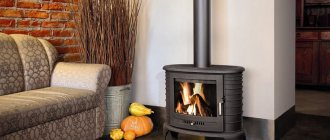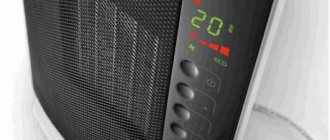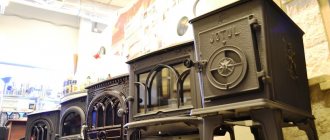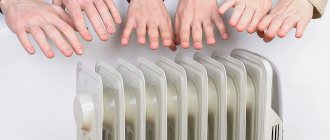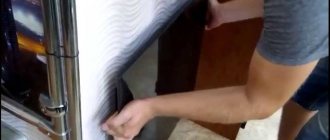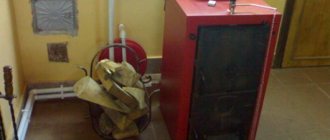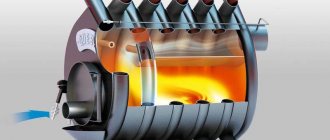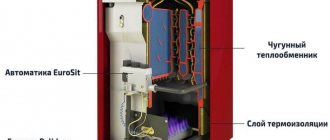Concrete floor screeds are the most common method of arranging them both in apartments and in private houses. If desired, you can install a “warm floor” system under it for greater comfort. In stores you can find many special mixtures for screeds - the article will present the best options, characterized by high quality and a reasonable price.
TOP floor screeds
Rating of the best building mixtures for floor screed
| Photo | Name | Rating | Price | |
| #1 | Holcim M300 | ⭐ 5 / 5 48 — votes | Find out the price | |
| #2 | Weber Vetonit 6000 | ⭐ 4.95 / 5 21 - voice | Find out the price | |
| #3 | Bolars | ⭐ 4.9 / 5 5 — votes | Find out the price | |
| #4 | Paladium Palafloor-307 | ⭐ 4.8 / 5 5 — votes | Find out the price | |
| #5 | Vilis M-300 | ⭐ 4.8 / 5 2 - votes | Find out the price | |
| #6 | Rusean M-300 | ⭐ 4.75 / 5 2 - votes | Find out the price | |
| #7 | NOVAMIX M-300 | ⭐ 4.75 / 5 6 — votes | Find out the price | |
| #8 | Stone Flower M-300 | ⭐ 4.75 / 5 3 - votes | Find out the price | |
| #9 | Titan M300 | ⭐ 4.65 / 5 2 - votes | Find out the price | |
| #10 | Axton | ⭐ 4.65 / 5 6 — votes | Find out the price | |
| #11 | KNAUF Tribon | ⭐ 4.6 / 5 4 - votes | Find out the price | |
| #12 | Ceresit CN 173 | ⭐ 4.6 / 5 11 — votes | Find out the price | |
| #13 | Eunice Horizon | ⭐ 4.55 / 5 10 — votes | Find out the price | |
| #14 | Perfecta (fibre layer) | ⭐ 4.5 / 5 7 — votes | Find out the price |
Which floor screeds would you choose and which ones would you recommend?
Take the survey
Mixtures for floor screed: composition
All screed mixtures can be divided into three groups according to their composition:
- Cement. Solutions of this group are ideal for any work. In this group the filler is sand. For quick drying and greater strength, plasticizers are added to the solution, which determine which screed to take: if they are large (>0.6 mm) then for rough leveling, if medium-sized (~ 0.6 mm) then for finishing, and if the smallest ones - then you need to take self-leveling compounds.
Example of cement-based mixtures - Plaster. Gypsum-based solutions are great in cases where you need to slightly level the wall. Such solutions are distinguished by their plasticity, lack of shrinkage, and quick drying. Well suited due to its hypoallergenic properties. Gypsum offers good heat-storing properties. True, there is one “but” - such material does not withstand moisture and quickly deteriorates from it.
Example of gypsum mixtures - Dry screeds. They are made on the basis of expanded clay or polystyrene. They combine well with any base, do not cause subsidence, and most importantly, you can work with such screeds immediately after applying them, which is why they are used for rough leveling.
Example of dry mixtures
Expert opinion: Afanasyev E.V.
Chief editor of the Stroyday.ru project. Engineer.
Already know how to properly make a floor screed? I have already prepared detailed instructions for screeding the floor, I advise you to read it!
Why can't you use a regular solution?
When pouring a heated floor, it is necessary to lay a compensation tape around the perimeter of the room.
Many who have undertaken to make a heated floor with their own hands and filled it with ordinary cement-sand mortar, the question arises as to why the screed cracked. There are several reasons for this:
- if a damper tape is not laid around the perimeter of the room, then any cement surface may crack during shrinkage;
- in underfloor heating systems, a very thin solution cannot be used;
- in a large room, filling is done with expansion joints;
- at each site the solution should be poured at a time, and not in stages;
- a concrete screed for a water floor heating system must be reinforced;
- failure to comply with the proportions (excess of plasticizer in the solution);
- after laying, the layer should dry on its own (without the floor heating system turned on);
- incorrect height of the leveling layer;
- When drying the solution, it is important to maintain the correct humidity and temperature in the room.
When installing electric and water heated floors with your own hands, the screed must be prepared in exact proportions, you must follow the instructions for its installation and maintain the correct conditions during the drying process.
If you use a special ready-made mixture to level a heated floor, you can avoid many troubles with respect to proportions, poor quality of the solution and cracking. There are various ready-made compositions on sale for pouring rough screed for heated floors. They all differ in characteristics, price and manufacturer. It is difficult to say which mixture is better; it all depends on compliance with the floor laying technology.
Criteria for choosing a mixture for floor screed
Everyone is looking for a good dry mix for floor screed. And many people immediately pay attention to their packaging. It usually shows a level of quality and high strength.
Based on the set of rules SP 29.13330.2011, all floor screeds can be classified according to several indicators:
- adhesive and compressive strength;
- frost resistance (indicated by the letter F and a two-digit number);
- thickness;
- concrete class (denoted by the letter M and a three-digit number).
Of all the mixtures containing cement and sand, the M300 mixture . Although its full strength is not achieved immediately, but over time, you can walk within a couple of days after application. The three-digit number indicates the pressure exerted on the material.
Important! The number 500 is the maximum possible compression pressure (kg/cm3).
Brands
When choosing a dry ready-mix, you should give preference only to high-quality products. There are well-known brands that have proven themselves on the positive side. These include the following companies.
Knauf
The UBO Knauf cement-based mixture using granulated polystyrene foam has good thermal insulation and soundproofing. It is used as a universal solution that does not require additional coatings.
Boden Knauf's gypsum-based mixture using polymers allows you to create very thin surfaces from 2-15 mm. Thanks to these mixtures, it is possible to level out unevenness reaching 35 mm in height (even 80 mm).
- For roughing, Boden 30 mixture is suitable.
- Boden 15 is used as a self-leveling product based on gypsum with the addition of plasticizers.
- For universal processing, use Boden 25 on a gypsum basis with the addition of mineral components.
Ceresit
The CN 80 mixture is used for rough processing. The universal building mixture marked CN 175, CN 76, CN 88, Tomsit DG does not require additional coatings and dries very quickly. CN 68, Thomsit D, Thomsit DD is used as self-leveling. Levels substrates up to 60 mm thick.
"Osnovit" "Staroline T-41", "Mixline T-44" are universal mixtures. Level surfaces up to 150 mm thick.
Grupa Altas
The mixture “Typhoon Master No. 44, No. 45” is suitable for initial surface treatment.
- The mixture “Typhoon Master No. 41, No. 48” is used as a self-leveling mixture.
- "Typhoon Master No. 40, No. 47" is used as a universal mixture.
"Sarmat"
Mixtures “Optimal”, “Sarmat NV-42”, “Sarmat NV-40” are suitable for primary treatment of bases with large uneven areas.
- The Sarmat NV-45 mixture can be used as a self-leveling mixture.
- "Sarmat NV-43" is used as a universal solution.
Unis
The “Horizon” mixture is suitable for the initial treatment of bases with large uneven surfaces, and “Horizon-2” is used as a self-leveling mixture. “Horizon Eco-Pol” is used for universal floor treatment.
Bergauf
Base and Easy Boden mixtures are suitable for the initial treatment of bases with large uneven surfaces. Boden Inter Gross is used for universal surface treatment.
Ilmax
The ilmax X-plan mixture is used as a self-leveling mixture, and Ilmax 6600, Ilmax 6650, Ilmax 6705 gypsplan, Ilmax 6715 rapidplan are used as universal floor coverings.
Compositions based on well-known brands have similar components, but differ only in the type of sand. Small grains contribute to the formation of a more liquid consistency. The type of initial surface determines the use of a particular brand.
Universal products are convenient because they do not require additional coatings. However, their use requires special qualifications and knowledge. It is better to purchase the mixture in large stores.
Please pay attention to the release date. The earlier it was released, the worse the quality
Preparing the mixture
If the mixture was purchased ready-made, then there are usually no problems with it. All you need to do is follow the manufacturer’s recommendations, which are on the packaging or in the instructions for use. You just need to thoroughly knead the entire mixture with a construction mixer until it reaches a homogeneous consistency, reminiscent of sour cream.
If you wish, you can not take the ready-made mixture, but make it yourself. For example, to obtain M300 you need to take part of the M400 cement mixture and mix it with two parts of sifted clean sand.
Preparing the mixture is a simple matter
How much mixture do you need?
In addition to the issue of manufacturing and application, you need to think about the consumption of the mixture. As a rule, this data is indicated on the packaging, but since each has its own conditions, it is necessary to carry out calculations. But before that, you need to measure the area of the floor that needs to be filled with this screed. The calculation will look like this:
- a layer 1 cm thick will require the use of 22 kg of mixture per square meter of room area;
- the optimal layer of screed is 3 cm, which means that 22*3=66 kg of mixture must be spent per square meter of area.
Important! It happens that there are large differences in the floor in a room; they must be leveled.
When choosing a mixture, you can always simply use a calculator to accurately calculate the required amount of mixture - everyone has a calculator.
Important! If a warm floor is installed, then a layer of 40 mm or more is needed.
You need to correctly calculate the amount of mixture before using it.
Calculator for calculating the amount of mixture for floor screed
Go to calculations
Preparatory work
Before you begin installing underfloor heating heating elements, you should perform several very important steps in sequence:
- Determining the location of the thermostat. It attaches like a regular switch. The most optimal distance from the floor is 30 cm. There is no point in installing it below. In addition to drilling a hole in the wall for the thermostat, a hole is also made from it perpendicular to the base of the floor, where the power wire and other corrugated wires will be placed.
- Preparing the subfloor. All debris and dust are removed and the surface is thoroughly leveled. There should be no holes or drops. When leveling is carried out, the thickness of the screed for electric underfloor heating is at least 30 mm. Otherwise, the screed will begin to crack. Before distributing the solution over the surface, apply a layer of primer. In addition, areas where the furniture will be located are marked, and indents from the walls to the heating elements are also marked, which must be at least 50 mm.
- Insulation layer. It allows you to reduce heat loss by about 30%. Insulation can be laid not only vertically, but also horizontally. For vertical insulation, damper tape is used, as well as polystyrene sheets, the width of which is 15-20 cm. Heat loss will be reduced through the outer walls of the room. As for horizontal distribution, here it is laid on a prepared concrete base. The thickness of the sheets is usually at least 20 mm.
If there is a room with a high level of humidity, an additional waterproofing layer is installed.
How to apply mixtures
The key to success is careful preparation for pouring. To do all this, the surface must first be thoroughly cleaned of debris. Then you need to make sure there are no cracks.
After this, beacons should be placed. It will be clear from them when and how many cm of the mixture layer will be needed. They are placed around the perimeter in different places. When installing beating cords, the potential installer understands how much mixture will need to be installed.
Interesting! Lighthouse slats are much more convenient than bars when it comes to reinforced flooring. Half a day after applying the composition, you can work with the equipment.
Next is laying the mixture. It occurs in the form of breaking into sections with further processing of each of them. The solution is poured between the beacons until the level of the mixture reaches the desired level. Work begins from the far corner and moves closer to the front door.
If there are gaps, then the solution is simply added to them, without spreading it over the entire area where the mixture has already been poured. It turns out that the residues are discarded, and the screed is leveled. If you do everything correctly, then there will be less chance of touching the emerging floor.
You can walk on the flooded floor within a few hours. If tubercles are found, they are cut off immediately.
The longer the floor takes to dry, the more difficult it will be to remove defects.
Towards the end of the work, when the formed floor has already acquired sufficient strength, the surface is grouted. But this is not the end of the work. After grouting, you need a little more than a week (to be more precise, 10 days) to moisten the screed. As a rule, this is done with a spray gun, but it can also be done with a roller. Why should this be done? This is the only way to achieve uniform drying of the cement used to screed the floor.
Important! Do not open windows, creating drafts. This will cause the solution to lose its natural moisture.
The load should be increasing. First you need to lay wooden slats and walk cleanly on them. Over time, you can increase the load - walk one at a time, then remove them completely. The result can be seen after a certain period of time - usually two weeks.
Important! The first thing to be checked is the color. It will show how evenly the composition has been distributed and dried. The second is the presence of gaps that need to be closed quickly, while the mixture is still suitable for processing.
In general, if we talk about pouring or screeding a floor, we can say that it is not so much complicated as it is labor-intensive. But if you follow all the tips, requests and recommendations, the manufacturer’s style and the technical process, then nothing will stop you from making your own floor screed.
You may be interested in knowing which external wall insulation to choose .
Laying heating elements
When you have a plan for laying the heating elements in hand, you can begin all the steps. Particular attention should be paid to the installation step. Before unwinding the cable, you should check its resistance. This data is written down in the warranty card. It is worth noting that they must fully comply with the data on the label. Differences in indicators are allowed, but not more than 10 percent.
The cold end of the heating cable should be placed in a corrugation, and then installed in the groove made. The beginning of the cable should be secured to the mounting tape at the base of the floor. It is from this section that the cable laying will begin. Subsequently, the coupling must be completely covered with concrete screed.
All heating cable lines must not connect or cross each other. Throughout the entire area of the room, the laying step that has been selected in advance must be maintained. In those areas where it is necessary to bend the cable, its radius must be more than 50 mm. Both subfloor heating cables must be attached to the installed thermostat.
TOP 14 best floor screeds
Perfecta (fibre layer)
Perfekta (fibre layer)
Our rating begins with a model of floor screed, which has been evaluated more than once on the positive side. It dries quite quickly - it takes two to three hours to dry for 1 cm of layer. Consumption – 17 kg per square, which is considered a small indicator.
The consistency of the finished screed solution resembles thick kefir. The composition is not self-leveling, so it is better to work with a flat floor, the thickness of which is 5-12 cm.
This dry mixture will be a good option for heated floors. It will come in handy not only when filling a water heating circuit, but also when building an electric version.
Important! The manufacturer’s main condition is that the layer thickness should be more than 2 or even 3 cm, which will provide strength and resistance to loads.
According to Perfekt's recommendations, the floor covering becomes functional a week after installation. Ceramic can be used the next day.
pros
- high-quality reinforcement;
- the shortest time for laying the coating;
- resistance to temperature changes, frost, heat.
Minuses
- wait a long time before installing flooring (exception is ceramic tiles).
Perfecta (fibre layer)
Eunice Horizon
Eunice Horizon
Eunice Horizon is a dry screed that is successfully used by domestic buyers when screeding a floor or installing a “warm” variation of it. There is increased resistance to moisture, which is important when laying on a wet base.
Important! Laying on a wet base will not cause the Eunice Horizon screed to swell or crack.
The process of filling the floor with Eunice Horizon mixture is quite simple. At the same time, interestingly, the consumption of the mixture per square meter is quite profitable - 19 kg/m2 with a layer thickness of only 10 mm.
The dry mixture can be used in two ways:
- floor screed (layer thickness is 5-10 mm);
- preparing a new foundation (if the person who bought the mixture has a new building or needs to carry out a major renovation of the apartment).
One of the advantages for which this screed is used is the ability to walk on the new floor after just a few hours, although final drying takes longer - about a week. It is also worth noting the smoothness of the surface formed by the screed, as well as how smooth the floor becomes after applying the mixture.
Although this mixture is more expensive than cheaper options, it will provide exactly what many people need - a high-quality floor screed.
pros
- quick drying;
- low consumption;
- wide scope of application.
Minuses
- final drying takes a long time.
Eunice Horizon
Ceresit CN 173
Ceresit CN 173
This model from Ceresit is perfect for floor screed if you prepare the working solution correctly and use it in the future.
The use of this mixture will be beneficial when organizing electric or water heated floors. The reason for this is the lack of shrinkage and rapid leveling of the floor after installing the “warm floor” system.
This mixture model can be used not only for floor screeding, but also for major repairs. In any case, the coating will harden within 6 hours, and strength appears the very next day after application. This is what distinguishes CN 173 from ordinary sand concrete.
pros
- low price;
- high strength;
- fast initial drying.
Minuses
- there are difficulties in working with this mixture;
- proportions must be carefully observed.
Ceresit CN 173
KNAUF Tribon
KNAUF Tribon
Next up is a mixture from the famous company Knauf. It is immediately worth noting that it can be used in two situations:
- screed (it is laid on top of old wood or any other covering);
- pouring (new floor or “warm floor” system).
It is noted that for the water version of the circuit it is necessary to use a larger amount of solution obtained from this mixture. The thickness formed when screeding the floor does not exceed 60 mm. Consumption with this model from Knauf is 17 kg per 1 m2 with a layer thickness of 10 mm.
In terms of overall strength, this model is superior to most sand-concrete options. The floor dries quite quickly (the floor can be walked on after just six hours, but it gains the necessary strength after a day). The fluidity of this model is quite high, so it will be easier for him to distribute.
A separate advantage was the availability of the necessary European certificates of conformity - there is no doubt about the quality of the mixture.
pros
- dries quite quickly;
- gives an even, durable layer;
- easy to work.
Minuses
- very demanding in preparing the foundation;
- You can’t skimp on primer;
- high price.
KNAUF Tribon
Axton
Axton
One of the options for leveling the floor is Axton products. It is perfect not only for dry, but also for wet rooms.
The mixture is quite popular among other competitors not only because of the speed of drying of the coating and the increase in strength, but also because the coating does not shrink and does not crack.
Important! The minimum floor thickness is 10 mm, the maximum is 80 mm.
The consumption of dry mixture per 1 m2, depending on the thickness of the layer (up to 1.5 cm), can be up to 30 kg (approximate weight of one bag). If the thickness is 2 cm, then you will need 40 kg of the mixture. It turns out the following: for a screed of 150 m2 you need to purchase 150 bags of 30 kg each.
The composition, interestingly, is suitable not only for indoor spaces, but also for outdoor ones. This is justified not only by protection from heat, but also from noise.
pros
- easy leveling;
- good moisture resistant qualities;
- good noise and heat insulation;
- economical consumption;
- small fractions of stones.
Minuses
- it will be possible to make a layer that is not too thick;
- Equipment cannot be installed in sub-zero temperatures.
Axton
Titan M300
Titan M300
This brand of sand concrete was included in the rating for a reason. It attracts with its price - it stands out sharply among other dry mixes on the construction market in the Russian Federation. It can not only be used to screed an existing coating or underfloor heating system, but also to fill a new one. The resulting screed, by the way, stands out for its high strength.
The packaging of this model is quite convenient, and preparing a solution based on this dry mixture is quite simple.
It will take about two hours for the floor to harden after applying the solution, which will allow you to quickly level the floor if necessary. There will be no shrinkage, which is important.
The composition of Titan M300 is as follows:
- Portland cement;
- granotsev (fraction – up to 5 mm);
- sifted river sand (fraction - about 3 mm);
Due to its composition, this model of sand concrete does not create shrinkage during hardening. An affordable price and good data have caused the appearance of counterfeits, so a potential buyer needs to look closely at the product, because there is a chance of being defective.
pros
- fast hardening;
- wide scope of application;
- low strength.
Minuses
- there is a chance of getting married.
Titan M300
Stone Flower M-300
Stone Flower M-300
Next is another domestic model of dry screed. It has everything you need for a high-quality screed or pouring of the floor. It is easy to fill and level it to a level or based on beacons. It is worth noting that this domestic brand levels well and hardens quickly.
Important! The consumption per 1 m2 of this model is not too high - 20-25 kg with a layer thickness of 10 mm.
The “Stone Flower” mixture can be used when installing a water-heated floor, which is important in winter. Preparation of the solution becomes much simpler, which makes it easier to install a “warm floor”.
This model is distinguished by its resistance to low temperatures, which allows the dry mixture to be used not only inside, but also outside of a house or apartment.
In general, this model offers a high density of the solution, good strength indicators, and ease of working with the mixture. This is all a potential buyer needs.
pros
- high quality screed;
- wide scope of application;
- resistance to temperature changes.
Minuses
- takes a long time to dry.
Stone Flower M-300
NOVAMIX M-300
NOVAMIX M-300
One of the good options for dry screeds can be this model from Novamix, formed by mixing M500 cement and sand.
You can use it to screed the floor, being confident in the quality result. And it will, because with such a mixture there will be no shrinkage if the proportions of the components when preparing the solution were observed. But not only screed can be made using this model of dry mixture - you can also use it for the initial filling of floors. The mixture hardens within two hours, and during this period of time the surface can be leveled to the maximum.
With a solution made on the basis of this mixture, you don’t have to worry about pouring or screeding the floor - it will be durable in any case and will not have a water film.
Important! This model is also suitable for outdoor work, as it has high resistance to weather conditions, including frost.
pros
- dries quickly;
- the material is inexpensive;
- high quality screed;
- frost resistance.
Minuses
- Care is required when maintaining proportions.
NOVAMIX M-300
Rusean M-300
Rusean M-300
Among dry sand concrete mixtures, Rusean M-300 is one of the most popular on the market and has proven itself to be particularly durable - it is used for screeding in rooms where a large load on the floor is planned. Preparation of the finished solution requires high precision - a lack of water will not allow the surface to be fully leveled, and its excess will reduce the strength and, when drying, can lead to the formation of cracks.
Judging by the reviews, Rusean M-300 dries quite slowly - it takes about two days to be able to safely walk on the screed. Further work (laying flooring) should be carried out only after complete drying, which occurs 7-10 days after pouring. For one square meter 10 mm thick, about 22 kg of dry sand concrete is consumed. It is often used when installing “warm” floors, since the high density of the solution (2.1 t/m²) allows you to make a thin rough screed of 10-15 mm, which, nevertheless, will be a fairly durable coating.
pros
- low price;
- wide scope of application;
- frost resistance;
- large layer thickness.
Minuses
- you will have to wait a long time until strength is gained;
- large fraction of stones;
- high consumption.
You might be interested in knowing what damper tape is .
Rusean M-300
Vilis M-300
Vilis M-300
This sand concrete is one of the options for pouring a floor from scratch. The high-strength floor that appears as a result of pouring the ready-made mortar is based on the composition of Vilis - in addition to M400 concrete, it contains coarse sand.
It is worth noting that full operation of the finished solution is possible only if it is prepared correctly. As it dries, the screed applied to the floor acquires the required strength. The material itself does not shrink, which is important when leveling the floor in any room. High plasticity can also be distinguished.
Important! This mixture is also used when installing “warm floors”.
What’s interesting is that Vilis can be used not only inside a house/apartment, but also outside. This is due to its high resistance to cold, as well as wear resistance. In other words, the mixture will not crack or crumble.
As a result, it is possible to save money, but obtain a high-quality dry mixture from which the floor screed solution will be made.
pros
- high strength;
- wide scope of application;
- resistance to frost and wear;
- plastic.
Minuses
- takes a long time to dry.
Vilis M-300
Paladium Palafloor-307
Paladium Palafloor-307
A dry mix from Paladium could be a rather interesting option. Its not-so-great popularity may surprise a potential buyer by the presence of something that all previous models could not provide.
Made from cement and foam glass, this dry mixture can offer excellent noise and heat insulation. With it you can forget not only about the cold, but also about the noise from your neighbors.
This model deserves attention for other reasons. For example, the composition. It turned out to be environmentally friendly enough to use the mixture for floor screeding in places where there are always a lot of people or there is a child.
The thickness range turned out to be quite large - from 0.2 cm to 3 cm. This makes it quite easy to approach the issue of screed. Since the mass of the mixture will be small, it can be used to restore housing that is in “dire condition.” Also, this mixture will surprise many with the fairly high quality of the screed and the ease of working with it.
The model could not get a higher place for two reasons: high price and long drying time (two days).
pros
- retains heat well;
- reduces background noise;
- environmental friendliness of the composition;
- high quality screed:
- wide range of thickness.
Minuses
- high price;
- long drying.
Paladium Palafloor-307
Bolars
Bolars
“Bronze” is awarded to the Bolars fast-hardening floor screed. It is recommended for use not only when screeding, but also when pouring a new floor. All construction work is carried out only at positive temperatures, and the coating can be used even at sub-zero temperatures. The layer dries quite quickly - on average you need to wait five hours before you can walk on the screed.
Important! Finishing is carried out after at least three days. Maximum - in two weeks.
This model offers not only high screed strength, but also resistance to moisture and sudden temperature changes.
This model has one “but” - not all bases can be leveled with one layer, and the layer itself will not be too thick.
pros
- resistance to temperature changes, moisture and frost;
- high screed strength;
- easy to apply;
- dries quickly.
Minuses
- You can only make a thin layer.
Bolars floor screed
Weber Vetonit 6000
Weber Vetonit 6000
This model is ideal for basic and any other type of floor leveling. The fairly high quality and versatility of the composition only further confirm the ideality of this model of dry screed. Many other things can be said about this model: it dries quickly (three hours on average), makes the floor very durable, and does not create shrinkage, peeling or cracks.
Important! The manufacturer recommends making a layer of a certain thickness in the range of 10-250 mm.
Floor coverings can be laid 15 hours after the solution has been spilled over the entire floor. You can also use it to screed “warm floors”, water or electric – it doesn’t matter.
pros
- ease of preparation;
- wide range of mortar layer thicknesses;
- quick drying (average three hours);
- high strength.
Minuses
- not detected.
Weber Vetonit 6000
Holcim M300
Holcim M300
This mixture is successfully used not only for a home or apartment, but also outdoors. With its help, you can make garden paths or screed a “warm floor” system, no matter whether it is electric or water.
To prepare the solution, Portland cement and coarse sand are used. The quality of the components is very high, as many builders working in new buildings have seen. What is important to them is the quality of the raw materials and what their composition is.
Interesting! When hardened, this solution acquires a bluish tint.
If you prepare the solution correctly, you can not only ensure a high-quality floor covering, but also make the surface as smooth as possible.
Judging by numerous reviews from ordinary people and professionals, this model of dry mix can claim the title of “ideal dry mix for floors.”
pros
- versatility;
- wide range of thicknesses;
- quick drying;
- high strength.
Minuses
- not detected.
Holcim M300
Temperature sensor and thermostat
After this, the temperature sensor is installed. It is placed in a corrugated pipe, installed together with the supply end of the heating cable. To prevent solution from getting into the tube with the thermostat during the pouring process, a special plug is made. In this case, there will be no problems with replacing the sensor during operation and its failure.
The sensor is laid on the floor so as not to cross the lines of the heating cable. The best fixation option is in the middle of the cable lines, directly on the mounting tape.
The thermostat can only be installed if three main cables are connected to the junction box:
- The wire of the temperature sensor itself.
- Network cable with a voltage of 220 V.
- Heating cable wire.
If the room has a high level of humidity, then it is prohibited to install a thermostat in it. This is contrary to all safety requirements.
When all the above steps have been completed, you can think about preparing the solution and pouring a concrete screed, which has its own characteristics and installation subtleties.
Voting: the best floor screeds
Which floor screeds would you choose and which ones would you recommend?
Holcim M300
36.36 % ( 48 )
Weber Vetonit 6000
15.91 % ( 21 )
Bolars
3.79 % ( 5 )
Paladium Palafloor-307
3.79 % ( 5 )
Vilis M-300
1.52 % ( 2 )
Rusean M-300
1.52 % ( 2 )
NOVAMIX M-300
4.55 % ( 6 )
Stone Flower M-300
2.27 % ( 3 )
Titan M300
1.52 % ( 2 )
Axton
4.55 % ( 6 )
KNAUF Tribon
3.03 % ( 4 )
Ceresit CN 173
8.33 % ( 11 )
Eunice Horizon
7.58 % ( 10 )

